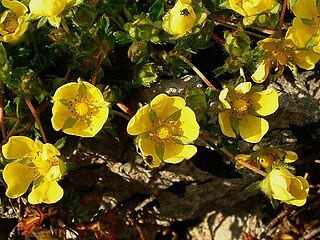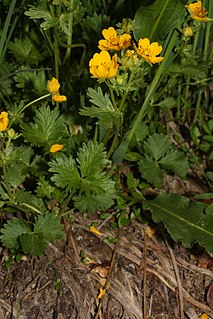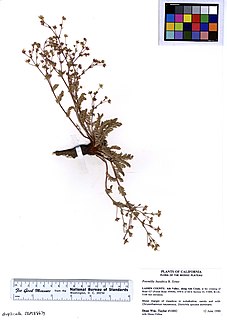
Potentilla is a genus containing over 300 species of annual, biennial and perennial herbaceous flowering plants in the rose family, Rosaceae. They are usually called cinquefoils in English. Potentilla are generally only found throughout the northern continents of the world (holarctic), though some may even be found in montane biomes of the New Guinea Highlands. Several other cinquefoils formerly included here are now separated in distinct genera - notably the popular garden shrub P. fruticosa, now Dasiphora fruticosa.

Potentilla erecta is a herbaceous perennial plant belonging to the rose family (Rosaceae).

Boulder Mountain in Utah, USA makes up half of the Aquarius Plateau of South Central Utah in Wayne and Garfield counties. The mountain rises to the west of Capitol Reef National Park and consists of steep slopes and cliffs with over 50,000 acres (200 km²) of rolling forest and meadowlands on the top. The mountain has a nearly flat summit of roughly 70 square miles. The mountain is the highest timbered plateau in North America and is part of the Dixie National Forest.

Potentilla neumanniana, the spring cinquefoil or spotted cinquefoil, is a flowering plant of the cinquefoil genus (Potentilla) in the rose family (Rosaceae).

Drymocallis arguta, commonly known as the tall cinquefoil, prairie cinquefoil, or sticky cinquefoil, is a perennial herbaceous plant native to North America. It was formerly included with the typical cinquefoils in the genus Potentilla.

Potentilla robbinsiana, the dwarf mountain cinquefoil or Robbins' cinquefoil, is a small, yellow-flowered, perennial found exclusively above the tree line in the White Mountains of New Hampshire. The plant is nearly stemless and measures two to four centimeters in diameter.

Drymocallis is a genus of plants formerly included with the typical cinquefoils (Potentilla). It contains three species known or suspected to be protocarnivorous, but more cinquefoils might eventually be moved here:
Potentilla cristae is a rare species of cinquefoil known by the common name crested cinquefoil. It is endemic to the Klamath Mountains of far northern California, where it is known from a few occurrences in the subalpine and alpine climates of the high mountain ridges. It grows in talus and moist rocky or gravelly serpentine soils. This is a low, matted plant producing a clump of hairy, glandular herbage up to about 20 centimeters tall. Each hairy leaf is divided into three rounded leaflets which are toothed or lobed and measure up to 2 centimeters in length. The inflorescence is a cyme of a few flowers, each with five small yellow petals. The fruit is a minute achene just a millimeter wide, which is smooth with a crest.

Potentilla diversifolia or Potentilla × diversifolia is a species of flowering plant in the Rose Family (Rosaceae) known by the common names varileaf cinquefoil, different-leaved cinquefoil, and mountain meadow cinquefoil.

Potentilla flabellifolia is a species of cinquefoil known by the common names high mountain cinquefoil, fanleaf cinquefoil and fan-foil.
Potentilla grayi is a species of cinquefoil known by the common name Gray's cinquefoil.
Potentilla millefolia is a species of cinquefoil known by the common names cutleaf cinquefoil and feather cinquefoil. It is native to Oregon, Nevada and eastern California, where it grows in moist mountain meadows and similar habitat. The plant produces a basal rosette from a taproot, then a decumbent stem up to about 20 centimeters in maximum length. The elongated leaves are made up of several overlapping pairs of deeply lobed leaflets. The inflorescence at the tip of the stem is a cyme of a few flowers, each with usually five yellow petals under a centimeter long.

Potentilla morefieldii is a species of cinquefoil known by the common name Morefield's cinquefoil. It is endemic to eastern California, where it is known from just a few occurrences in the White Mountains. It grows in rocky habitat such as talus in alpine climates. This cinquefoil was considered part of the Potentilla drummondii complex until 1992, when it was separated and elevated to species status. This is a small tufted plant with hairy or woolly foliage. The leaves are each made up of several overlapping pairs of lobed leaflets which are green and rough-haired on the upper surfaces and white and woolly-haired underneath. The inflorescence is a cyme of up to 15 flowers with bright yellow petals.
Potentilla pseudosericea is a species of cinquefoil known by the common names silky cinquefoil and Mono cinquefoil. It is native to the Sierra Nevada of California and mountain ranges just to the east, where its distribution extends into Nevada. It grows in rocky mountainous habitat. It is a small plant forming mats or tufts in rock cracks and talus, its short stem growing from a caudex. The leaves are generally palmate, divided into five leaflets. The leaflets are deeply lobed along the edges and woolly in texture, coated in white or silvery hairs. The inflorescence is a cluster of a few yellow flowers with petals around 3 millimeters long each.
Potentilla rimicola is a species of cinquefoil-Potentilla, known by the common name cliff cinquefoil.

Astragalus montii is a rare species of flowering plant in the legume family known by the common name heliotrope milkvetch. It is endemic to Utah in the United States, where there are only three known populations. It is a federally listed threatened species of the United States. This species is often treated as a variety of Astragalus limnocharis.
Potentilla cottamii is a rare species of flowering plant in the rose family known by the common names Cottam's cinquefoil and Pilot Range cinquefoil. It is native to Nevada and Utah in the United States. It occurs in the Pilot Range of Elko County, Nevada, and a small area of adjacent Utah.

Potentilla hippiana is a species of flowering plant in the rose family known by the common names woolly cinquefoil, horse cinquefoil, and Hipp's cinquefoil. It is native to North America, where it occurs in western Canada and the western United States. It occurs in eastern Canada and the US state of Michigan as an introduced species.

Potentilla basaltica is a species of flowering plant in the rose family known by the common names Soldier Meadows cinquefoil and basalt cinquefoil. It is endemic to a small area of the Modoc Plateau and Warner Mountains in northeastern California and northwestern Nevada.

















